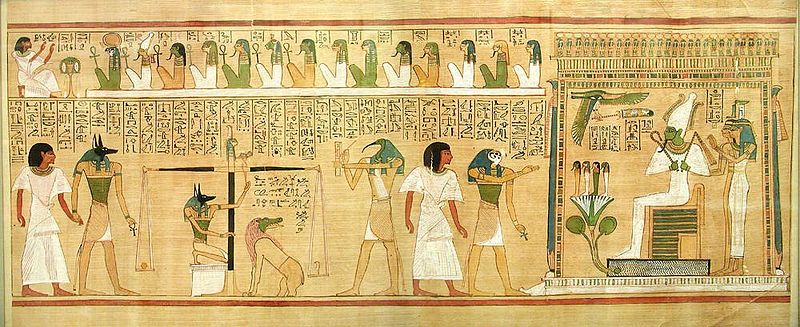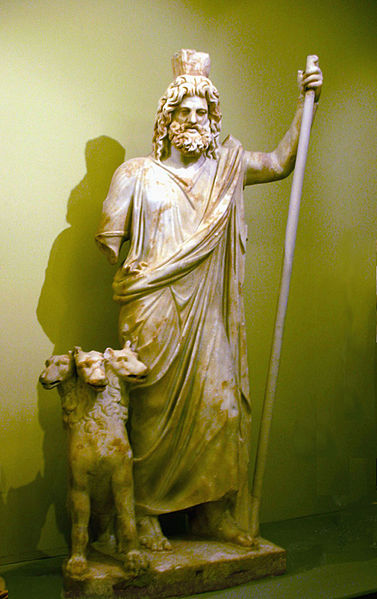Inicio » Publicaciones con la etiqueta 'grecia'
Archivo de la etiqueta: grecia
Los señores del Inframundo / The Lords of the Underworld
Desde que tiene conciencia del mundo, el hombre siempre ha sentido una curiosidad y un temor sobre si existe algo después de la muerte.
Todas las culturas antiguas han tenido su concepción del mundo que les espera a los hombres después de su último día en la Tierra. Nosotros hemos reunido cuatro de varias de las más importantes culturas que han poblado nuestro planeta para hacer un breve análisis sobre ellas.
El salón subterráneo de Ereshkigal
Para los mesopotámicos la muerte era la entrada en el mundo de las sombras del olvido. Un lugar triste donde los muertos deambulaban en la oscuridad. Allí, custodiada por una legión de demonios Pazuzu y protegida por siete puertas que impedían la entrada a nadie que portara ninguna clase de arma moraba Ereshkigal, la señora tenebrosa.
Ereshkigal, siempre enfrentada a su hermana menor Ishtar, a quien se atreve a ningunear y con quien se disputa el honor de ser la diosa más hermosa del panteón babilónico, es en el fondo una diosa sentimental. Su historia de amor hacia Nergal así nos lo indica, en contraposición con la voluptuosa y voluble Ishtar, que otorga sus favores sexuales a quien le apetece en cada ocasión.
No siempre fue Ereshkigal la reina del inframundo, sino que, en un caso parecido a la de la helena Perséfone, fue raptada, en su caso por el dragón Kur, y obligada a permanecer allí por siempre.
En el Amenti, junto a Osiris
De todos los dioses del Inframundo, habidos y por haber, quizás el único que es básicamente benévolo y que no tiene connotaciones negativas, al menos muchas menos que otros dioses egipcios, es Osiris. Quizás porque Osiris es mucho más que un simple dios de los muertos y su historia ya es un relato sin el cual no se podría entender la civilización egipcia, y también porque el concepto egipcio de la muerte es mucho más positivo que el de cualquier otra civilización de la historia.
Juicio de Osiris a las almas del Inframundo / Judgment of Osiris to the souls of the Underworld. Fuente/Source: Wikipedia
De una forma similar a como gobernaba un faraón en la Tierra, en su propio reino llamado el Amenti, gobernaba Osiris en el Inframundo. Resucitado, y momificado por su esposa Isis, Osiris no podía casi moverse, pero su boca era justa y tanto hombres como dioses tenían fe de su capacidad de juicio.
El mundo de premios y castigos de Hades
La mitología griega está mucho más humanizada que las anteriores y por ello nos encontramos con que los grandes colosos, monstruos y titanes de tiempos remotos, pertenecientes a un tiempo olvidado, moran todos en una parte del Inframundo llamado Érebo o Tártaro. Esto sólo es una parte del reino de los muertos griego, que tiene otros mundos o divisiones, conocidas bajo el nombre de Campos Eliseos, para los bienaventurados, las islas de los afortunados, para los grandes héroes, la tierra de Asfódelos , Estigia y Aqueronte, y conco rios que los limitaban y separaban entre sí: Cócito, Flegeronte, Lete, Aqueronte y Estigia. Cada una de estas divisiones era gobernada por un Juez del Inframundo, pero el dios que los gobernaba a todos era Hades, hermano de Zeus y el tercero de los dioses mayores de la mitología griega.
Hades y Cerbero / Hades and Cerberus. Fuente/ Source: Wikipedia.
Hades es un dios sombrío, un incomprendido, un secundario, quizás un engañado por Zeus. Un dios omnipotente y temible en cualquier caso que juzga cada alma para llevarla a su ámbito del Inframundo correspondiente.
El señor del mal
La religión judía y después la cristiana ha simplificado y polarizado el mundo espiritual, convirtiéndolo en un escenario donde existe sólo el bien contra el mal y un cielo que premia a los bondadosos y un infierno que castiga a los malvados. El señor del infierno judeo – cristiano tiene muchos nombres, pero uno de los más conocidos es Lucifer.
Lucifer, el portador de la luz. No es un dios, es su antitesis. No crea, pervierte y destruye. No gobierna, domina. La figura antigua que más se le asemeja es el egipcio Seth y el fenicio – púnico Moloch. Pero un Seth muy tardío a quien la corriente maniquea ha despojado de cualquier atributo positivo y que se ha convertido en una sombra oscura revestido de una capa más sombría todavía, que ha olvidado para siempre la luz de la cual se adornó alguna vez.
El eterno temor
No podemos saber, a menos que creamos en alguna de las personas que dicen tener esa capacidad, saber lo que nos espera al otro lado, el temor a la muerte eterna es innato en el hombre y nunca desparecerá. Podemos creer que existe otro mundo, parecido al nuestro cuando traspasemos los límites de nuestra vida, pero lo más importante, como nos cuenta el mito de Gilgamesh, es dejar buenas obras durante nuestra existencia, pues son la mayor garantía de nuestra pervivencia.
Since he is aware of the world, man has always had a curiosity and fear about whether there is anything after death.
All ancient cultures have had their world awaits men after their last day on Earth. We have met four of several of the most important cultures that have populated our planet for a brief analysis on them.
The underground room of Ereshkigal
For Mesopotamians death was the entry into the world of the shadows of oblivion. A sad place where the dead wandering in the dark. There, guarded by a legion of demons Pazuzu and protected by seven gates that prevented the entrance one to carry any kind of weapon dwelt Ereshkigal, the dark lady.
Ereshkigal, always facing with her younger sister Ishtar, who dares to challenge and who will dispute the honor of being the most beautiful goddess of the Babylonian pantheon, is basically a sentimental goddess. Their love story with Nergal proves it, in contrast to the voluptuous and fickle Ishtar, who gives sexual favors to whom she want in every time.
She was not always the queen of the underworld, but in a case like that of the greek Persephone, was kidnapped, possibly by the dragon Kur, and forced to remain there forever.
In the Amenti, with Osiris
Of all the gods of the Underworld, have or might have, perhaps the only one which is basically benevolent and has no negative connotations, at least a lot less than other Egyptian gods, is Osiris. Perhaps because Osiris is much more than just a god of the dead and its history and is a story without which no one could understand the Egyptian civilization, and also because the Egyptian concept of death is much more positive than that of any other civilization of history.
In a similar way as a pharaoh ruled on Earth, in his own kingdom called the Amenti, Osiris ruled the Underworld. Risen, and mummified by his wife Isis, Osiris could hardly move, but his mouth was fair and both men and gods had faith in her judgment.
The world of rewards and punishments of Hades
Greek mythology is much more humane than earlier and therefore we find that the big giants, monsters and titans of ancient times, belonging to a forgotten time, dwell in one part of the Underworld called Erebus and Tartarus. This is only a part of the kingdom of the dead Greek, which has other worlds or divisions, known under the name of the Champs Elysees, to the blessed, the islands of the lucky ones, to the great heroes, the land of Asphodel, Styx and Acheron and concomitant limited and rivers that separated each other: Cocytus, Flegeronte, Lethe, Acheron and Styx. Each of these divisions was governed by a Judge of the Underworld, but the god who ruled all was Hades, brother of Zeus and the third of the major gods of the Greek mythology.
Hades is a grim god , a misunderstood, a sub, maybe a tricked by Zeus. A powerful and awesome God in any case that judges each soul to take her corresponding field of the Underworld.
The lord of evil
The Jewish and Christian religions simplified and polarized the spiritual world, making it a scenario where there is only good against evil and a sky that rewards the carings and a hell to punish the wicked. The Lord of Hell Judeo – Christian has many names, but one of the best known is Lucifer.
Lucifer, the light bearer. Not a god, is its antithesis. Do not make, perverts and destroys. No rules, dominates. The ancient figure who most resembles is the Egyptian Seth and Phoenician – Punic Moloch. But a very late Seth current Manichean who has been stripped of any positive thing and that has become a dark shadow covered with a still dark layer who has forgotten forever light which once adorned.
The eternal fear
We can not know, unless we believe in some of the people who claim to have this ability, knowing what awaits us on the other side, the fear of eternal death is innate in man and never disappear. We believe that there is another world, like ours when we cross the boundaries of our lives, but more importantly, as we consider the myth of Gilgamesh, is to let good works for our existence, they are the best guarantee of our survival.
¿Encontrada la tumba de la familia de Alejandro Magno?
Uno de los personajes más importantes de la historia de la antigüedad es sin duda Alejandro Magno. En la antigua ciudad helena de Anfípolis es posible que se haya hallado la tumba de su mujer persa Roxana y de su hijo Alejandro IV
Estos dos personajes, no demasiado conocidos por los aficionados a la Historia ya que después de la muerte del genial conquistador fueron rápidamente apartados del poder y asesinados por sus generales, terminaron con su muerte con toda esperanza de que en Macedonia reinara nadie de su linaje, y también cualquier intento de unificar todos los inmensos territorios conquistados.
La tumba en cuestión ha sido hallada en Anfípolis, en un recinto circular de 3 metros de alto conocido desde 1965 bajo el nombre de «Kasta Tom».
La directora de la excavación, Katerina Peristeri, cree que aún es pronto para afirmar que esta sea realmente la tumba de Roxana y Alejandro, pero tiene la esperanza, basándose en las fuentes clásicas, de que así sea.

